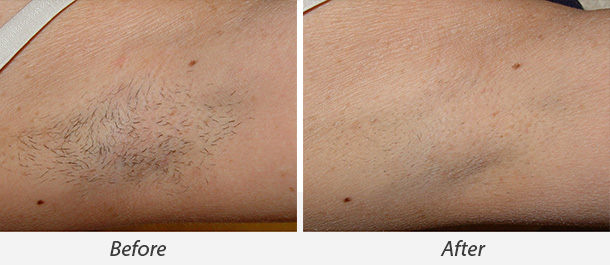Serving Beverly Hills, Los Angeles, Santa Barbara and surrounding areas
If you’ve tried shaving, tweezing, or waxing to remove unwanted hair and have been unhappy with the results, laser hair removal may be worth considering. It’s actually one of the most common cosmetic procedures in the U.S. Highly concentrated light is beamed into the hair follicles. Pigment in the follicles absorbs the light and that is what destroys the hair.

Laser treatment is useful for removing unwanted hair from the face, leg, arm, underarm, bikini line and other areas of the body.
Dr. Moradzadeh uses two different laser treatments for unwanted body hair, depending on the skin type. One laser is used for lighter skin and the other, allows for hair removal on dark skin without skin discoloration.
There are several advantages to laser hair removal:
- It’s precise. Lasers can selectively target dark, coarse hairs while leaving the surrounding skin undamaged.
- It’s fast. Every pulse of the laser takes a fraction of a second and can treat many hairs at the same time. The laser can treat an area approximately the size of a quarter every second. Small areas such as the upper lip can be treated in less than a minute — and larger areas, such as the back or legs, make up to an hour to treat.
- It’s reliable. Ninety percent of patients who undergo treatment experience permanent loss of unwanted hair after an average of four to six sessions.
Understanding the Procedure
Individuals who are planning on undergoing laser hair removal should limit plucking, waxing, and electrolysis for six weeks before treatment. That’s because the laser targets the hairs’ roots, which are temporarily removed by waxing or plucking. Patients should also avoid sun exposure for at least six weeks before and after treatment since this makes laser hair removal less effective and complications after treatment more likely.
Just before the procedure, the patient’s hair that will be undergoing treatment will be shaved at the skin surface. The laser equipment will be adjusted according to the color, thickness, and location of your hair being treated as well as the patient’s skin color.
Depending on the laser or light source used, the patient and the person performing the procedure will need to wear appropriate eye protection. It will also be necessary to protect the outer layers of the skin with a cold gel or special cooling device. This will help the laser light penetrate the skin. A pulse of light will then be administered to the treatment area.
Another treatment four to six weeks later will need to be scheduled, for as many times as are needed for the unwanted hair to stop growing.
What to Expect Afterwards
When the procedure is completed, the patient is given anti-inflammatory creams or lotions to ease any discomfort if needed. For a day or two afterward, the treated area of your skin may look and feel as though it is pink. Cool compresses and moisturizers may help.
 Cool Glide© hair removal- Safe on all skin colors
Cool Glide© hair removal- Safe on all skin colors Prowave 770© hair removal- Rapid reduction in hair density
Prowave 770© hair removal- Rapid reduction in hair densityOther Considerations
While the application of laser energies to the skin results in almost complete removal of all actively growing hairs in the treated area, patients will achieve varying degrees of success. The number of hairs that are permanently removed as a result of one treatment can vary. Part of the difficulty in eradication of unwanted or excess hair lies in the fact that the follicle has tremendous regenerative capabilities and that these recuperative powers are highly variable from individual to individual and from one anatomic site to another. In most instances multiple treatments are necessary in order to achieve permanent hair reduction and in some instances treatment may fail to permanently remove all the hair in a given anatomic site. Dr. Moradzadeh will be able to advise you what to expect.


